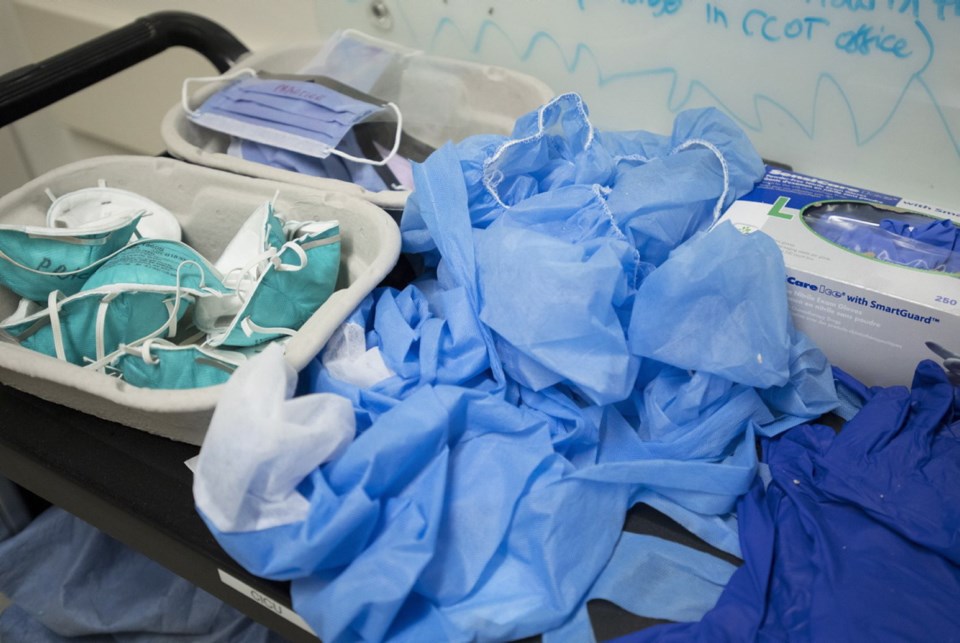Another good reason to get out and bang your pots and pans at 7 p.m. was presented in a health briefing this week. Twenty-one per cent of the COVID-19 cases in B.C. — 428 people — are in the broad category of health care workers. That includes doctors, nurses, dentistry, physiotherapists and all other care workers.
Their work puts them in a high-risk category and the statistics compiled to date show how much higher that risk is.
Public health officer Dr. Bonnie Henry said many of them acquired it at work, either from a colleague or from caring for patients. It also includes people who got infected through travel, by way of a big dental conference in Vancouver or from exposure to family members, she said.
A very small number of them — 8% — were hospitalized and an even smaller number required intensive care. One person died.
That survival rate is due to the fact they are in a younger age group and are mostly female. Both those factors increase the likelihood of good outcomes.
Those 428 people are also in a category — those who live or work in high risk situations — that suggests there is more leeway to allow for increased interaction in society at large.
There are also 266 long-term care residents in that category with COVID-19, and 134 people in the federal prison at Mission.
Although health care workers move in and out of the higher risk situations, the breakdown suggest the risk factor in the general population’s everyday lives is lower than the total count suggests.
That’s not a reason to let down your guard. But it’s likely a factor in the upcoming decision to gradually ease some of the restrictions on social interactions.
The gender breakdown is one of the many mysteries still unexplained.
More women than men have contracted COVID-19, 56% to 44%.
But far more men suffer severe consequences, are hospitalized and succumb to it.
Said Henry: “This is a phenomenon that we’re seeing around the world.
“We really don’t understand why. There is a lot of work going into trying to understand that phenomenon.”
Of the fatalities to date, 72% are male.
Those fatalities and others have contributed to a rise in the “all cause mortality rate,” deaths for all reasons.
It’s usually a stable number, but B.C. recorded 170 excess deaths over the norm to the end of April, of which 111 were attributed to COVID-19. (It’s now 121.) The exact reason for the other fatalities won’t be established until there’s more detailed information.
Henry said it’s likely some will be indirectly linked to the pandemic. “For example, we know that people were not going to the ER because of concerns about COVID-19 and it may be that there were excess deaths recorded from that.”
There was a smaller but noticeable uptick in the death rate in recent years during severe wildfire season, which was blamed on poor air quality.
The briefing also confirmed the difference between B.C.’s pandemic experience and the rest of the country, and the world.
In the 57 days since the pandemic took hold, B.C.’s case rate gradually increased to just under 500 cases per million population. The rest of Canada’s rate climbed to 1,500 cases per million, led by runaway growth in Quebec and to a lesser extent, Ontario.
There are differences in the testing regimes used to identify cases that may factor in. But the death rates don’t depend on tests and they show the same stark difference. B.C.’s is less than a third of the rest of Canada’s.
That’s attributed to timing, lessons learned from countries hit earlier and major preparation to provide good care.
The majority of those lost were seniors in long-term care homes where outbreaks developed quickly.
The province is following the much milder trend lines of Australia, Singapore, South Korea and Hong Kong.
Even as anticipation builds for how the restrictions will be relaxed, the warnings continue that “moving too quickly can only cause harm to us all.”



